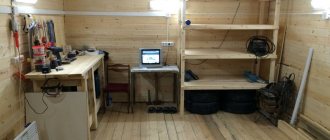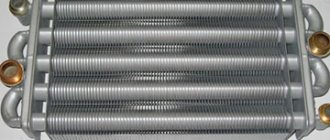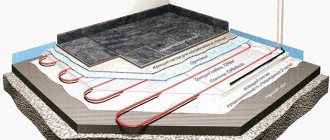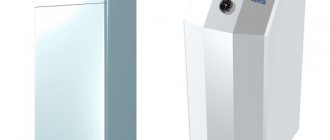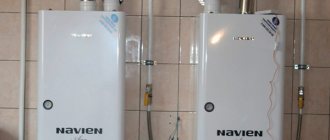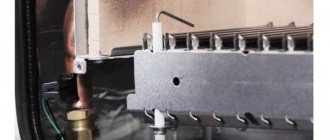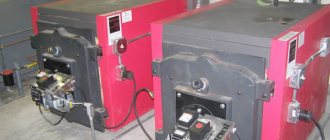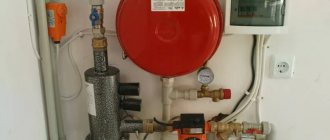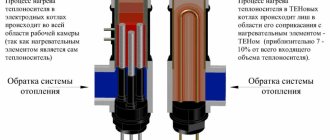Modern gas and solid fuel boilers are reliable mechanisms. However, technology does not last forever. And this equipment should be maintained regularly, like any other.
Many homeowners believe that since the boiler works and heats the house, then everything is in order and there is no need to do anything to it. This is actually a misconception. As practice has shown, gas boilers do not immediately fail; usually it all starts with a blockage or some minor malfunction, and if they are not immediately noticed, more serious mechanisms (electronics, heat exchanger, etc.) begin to “suffer.” And if cleaning the boiler and replacing the former will cost a penny, then replacing the latter will already cost serious money (sometimes as much as a new boiler costs).
This is why it is important to have your boiler cleaned and serviced regularly. And it is advisable to do this before the start of each heating season (or even better, 2 times a year: before the season and after).
Let's now look at what is included in such work.
Methods for cleaning the heat exchanger
Removal of scale and soot can be done mechanically or using special chemicals.
Mechanical cleaning
The cleaning process takes place using a foam sponge, a brush with soft bristles, and a mini high-pressure washer. The most effective of the listed tools, allowing you to quickly remove plaque and destroyed layers of scale, is a mini high-pressure washer.
Before cleaning, in order for the reaction to proceed efficiently, it is advisable to apply a special liquid for removing carbon deposits to the radiator plates, or treat the surface with dishwashing detergent. You can combine two methods of removing dirt and pour descaling liquid into the coil. After 30 - 40 minutes, and with the combined method after 30 - 180 minutes (depending on the type of reagent used), thoroughly rinse the elements of the flow radiator with water under pressure.
Cleaning with chemical reagents
Dry cleaning can take place at a static or dynamic pace. When using the static method, the heat exchanger is removed from the water heater and filled with the active substance:
- Hydrochloric acid (H2SO4) with additives to prevent active reaction with metal (inhibitors). When acid comes into contact with a metal surface, the protective layer is damaged and the thickness of the coil wall becomes thinner, so inhibitors are added to it to prevent corrosive wear. After flushing the radiator, the spent acid residues from the coil must be neutralized with an alkaline solution, such as soda dissolved in water, before being poured into the sewer.
- Orthophosphoric acid (H3PO4). Neutral agent, reacts well with carbonates, does not harm the metal components of the system. An effective reagent is obtained by mixing H3PO4 and water in a ratio of 1/6.
- Aminosulfonic acid (NH3SO3) is an iron oxide remover. To prevent metal parts from being subject to premature wear when cleaning the boiler heat exchanger, a liquid consisting of corrosion inhibitors, water with a concentration of NH3SO3 in an amount of 2-3% is used.
- Citric (C6H8O7) or acetic (C2H4O2) acid. These substances are less dangerous to metal and humans than hydrochloric, orthophosphoric and aminosulfonic acid. But the decalcification reaction lasts several times longer than when treated with hydrochloric or phosphoric acid. If 30-40 minutes are enough to react with the same amount of H2SO4 scale, then for citric and acetic acid the time increases to 3-4 hours.
- Special liquid for descaling. Specialized stores sell certified substances, for example, Detex, Boiler Cleaner E, which easily deal with scale. After some concentrates, it is necessary to additionally treat the cavities with an acidity neutralizer, while others do not need to be treated with a neutralizer, since they are neutral to the components of the system. Service centers should use only certified fluids. If this rule is observed, the company is guaranteed to have protection against claims from the owner whose heat exchanger has leaked after chemical cleaning.
The dynamic method of removing carbonates is carried out with special boosters. A booster is a device designed to circulate scale-active liquid both through the heating system and through its individual components. The flushing liquid used is the same as for static cleaning.
The use of H2SO4 causes premature corrosion of the metal parts of the booster.
All activities are carried out outdoors or in a well-ventilated area, using personal protective equipment (goggles, rubber gloves) and clothing that well covers parts of the body in order to prevent acid and fumes from entering the human body. To improve the catalytic reaction and reduce processing time, the contacting liquid should be 50 - 60°C.
What are the differences between cleaning a double-circuit gas boiler?
How to rinse the secondary heat exchanger of a gas boiler with your own hands? There are no fundamental differences between flushing the DHW circuit and the heating heat exchanger. It’s just that in the case of a dual-circuit model, you will have to clean not one, but two elements.
Double-circuit gas boilers can be equipped with two types of heat exchangers:
- removable secondary;
- bithermic.
The first option is cleaned in the same way as the primary circuit using manual or chemical cleaning using a booster:
- connect the booster hoses to the pipes for cold water supply and hot water outlet;
- The apparatus is put into operation with the reagent heated (t=50-55ºC).
For manual cleaning, the secondary circuit is dismantled and immersed in a citric acid solution. Then brush the outside and dry.
A bithermal heat exchanger consists of two pipes inserted into one another: coolant flows through one of them, hot water flows through the other. Cleaning it is much more difficult, especially since such a circuit cannot be dismantled as a separate analogue. Therefore, flushing the bithermal circuit can only be done using a booster. If such an element is heavily contaminated, then it is simply impossible to clean it. Then you will have to buy a new bithermic heat exchanger and install it in place of the old one.
Contact a professional or do it yourself
Professional cleaning of heating boilers is an expensive proposition. Depending on the condition of the equipment and the specifics of its operation, amounts can range from several tens to hundreds of dollars. In addition, the masters rarely arrive within the next few hours; sometimes you have to wait for them for several days. It is not comfortable.
The cost of professional cleaning using a special station for washing heat exchangers pays off: the parts are washed from the inside to a shine, and the equipment works much better. But if you want, you can always save money and do the same thing yourself. The result will be no worse, and you will only have to invest your own time and effort.
Professional device for washing heat exchangers
Procedure: how to clean the boiler from scale, soot and soot
If you decide to do the procedure for cleaning the structure yourself, before carrying out work at home, you need to turn off the electricity, turn off the gas, and close all valves of the heating system and boiler.
All actions should be carried out carefully; disassembly and assembly requires special care:
- The boiler cover is removed;
- Next, you should remove the gas burner, remove dirt in the form of carbon deposits from the electrodes, you can wash the surface with water and detergent, and rinse;
- Clean the injector and nozzles with a soft hair brush;
- Next, the fan is removed and its blades are cleaned;
- The wall of the AGV combustion chamber is removed;
- The heat exchanger should be cleaned of soot and descaled with citric acid or a special compound;
- Having dismantled the coil, it is necessary to clean the bottom of the boiler;
- Then the filter intended for cold water is cleaned, blown and rinsed with clean water;
- All parts are returned to their places;
- The tightness of the AOGV is checked.
After completing all the necessary procedures, you can open the gas valve and turn on the electricity.
When the boiler operates for a long enough time, contaminants in the form of carbon deposits gradually form on the burner. Accumulating in large quantities, it can cause equipment malfunctions. Therefore, it must be removed periodically.
For mechanical cleaning with small accumulations of dirt you will need:
- Brush;
- Yorshik;
- Thin needle.
The gas duct must be wiped clean. The surface of the nozzles is cleaned with brushes or a brush. A needle is used for holes. Under no circumstances should the hole be widened, as the combustion process may be disrupted.
If there is a lot of carbon deposits, you can use acidic solvents.
Rinsing and descaling
The procedure for removing scale from the internal heat exchange surfaces of gas boilers is performed in two ways: with and without removing the heat exchanger. If you intend to regularly clean and flush your heat generator, then it is more advisable to choose the second option. Each time disassembling the boiler to remove the heat exchanger is quite a troublesome task. Yes, and the designs of heaters are different, some need to be laid out almost by screws.
To wash the boiler without disassembling it, you will have to make a washing installation - a booster - with your own hands. It is a 15-20 liter container, filled with a washing solution, with connected hoses. Their ends are connected to the supply and return pipes of the heat generator and turn it on for heating. Circulation is provided by a separate pump, the same as in the heating system. It’s even better when the farm has a reversible pump to periodically change the direction of liquid flow.
In a booster for a bithermic heat exchanger, you should not use a water pump; it is better to find a circulation pump for heating
Advice. Place a mesh filter on the hose supplying the solution from the booster to the heating unit so that the scale does not circulate in a circle. It is possible that during washing it will have to be cleaned several times.
Before flushing the main heat exchanger of a gas boiler, you must perform the following operations:
- Reduce the pressure in the network to zero using a special valve (these are found in some boilers) or a Mayevsky tap on the nearest radiator;
- disconnect the heater from the system and empty it;
- check if your unit model has a built-in mud trap, remove and clean it.
A few words about how you can wash the heat exchanger of a gas boiler. The most popular folk remedy, safe for all elements of the heat generator, is a solution of citric acid and vinegar. According to reviews from users of a well-known forum, 9% vinegar or citric acid, dissolved at the rate of 20 g per 1 liter of water, works well. If necessary, the concentration can be increased.
In addition, there are many commercial products available for sale intended for chemical cleaning of heat exchangers (for example, Antiscale). The washing time is indicated on the product packaging, and when working with citric acid, the duration of the process depends on the degree of contamination and can take from 1 to 3 hours.
Advice. If a reversible pump is not available, then during operation periodically swap the hoses, starting the fluid flow in the opposite direction. If there is reverse flow, the heating must be turned off.
After finishing washing, fill the container with ordinary purified water and rinse the unit from chemicals and remaining dirt, and clean the mud trap again.
How to clean the heat exchanger of a floor-standing gas boiler
To disassemble a heating unit at home, you do not need any special tools; a regular set with screwdrivers, keys and pliers is sufficient. Preventive cleaning of the heat exchanger from soot and scale is carried out in the off-season, when the heating of the house is turned off. Having previously shut off the gas supply, we begin disassembling the boiler by removing the burner device in the following sequence:
- Disconnect all wires from the gas valve.
- Remove the thermocouple connected to the gas valve by a capillary tube from the combustion chamber.
- Disconnect the gas supply pipe.
- Unscrew the 4 nuts (or bolts) holding the stove with the burner. Pull the assembly out as shown in the photo:
The burner is removed along with the safety valve and mounting plate.
The gas boiler burner can be cleaned without further disassembly using an old toothbrush. The igniter, piezoelectric ignition device and flame control sensor (if equipped) should also be cleaned of soot. Now you need to get to the heat exchanger, for which you need to remove the top cover of the boiler, disconnect the draft sensor and the chimney pipe.
In the opened opening you will see insulation covering the chimney casing. Carefully remove the insulation, and then unscrew the screws securing the casing and remove it. Below it is a heat exchanger, from which you need to remove steel turbulators, as is done in the photo:
When removing the turbulators from the heat exchanger, the soot spills downwards, so the first thing to do is remove the burner
Cleaning the turbulators is easy; this can be done with a regular brush with metal bristles. But cleaning the heat exchanger of a floor-standing boiler is best done with the help of simple tools made by yourself according to the size of the smoke pipes. If they have a rectangular cross-section, then you need to bend a convenient flat spatula and a small scoop-shaped scraper from thin metal, then nail it to a wooden handle.
For round flame tubes, these same tools are made slightly curved. First, the walls of the pipes should be cleaned with a scoop, after which the soot remaining in the corners should be removed with a spatula.
At the end of the work, all surfaces of the heat exchanger can be cleaned with a brush screwed to a long handle. The last step is to remove soot from the bottom, where it was poured when cleaning the smoke pipes. This is what a clean heat exchanger of a heating unit looks like:
You can take a closer look at how to clean a gas boiler at home in the video:
Watch this video on YouTube
Work carried out and its frequency
Before the start of the heating season and after it, you need to perform a number of procedures, including cleaning:
- igniter;
- burners with nozzles;
- gas filter;
- heat exchanger;
- combustion chambers;
- chimney.
If some negative aspects arise, there is no need to postpone this matter and you need to clean the device immediately:
- If the boiler is operating in standard mode, but the room temperature has become lower.
- The unit began to consume more gas and electricity.
- The smell of carbon monoxide began to be heard in the room.
How to calculate the gas consumption of a boiler?
A gas filter is used to clean the incoming gas from various contaminants and impurities. In this regard, it is especially important to clean it in a timely manner.
Often such situations arise as a result of a clogged boiler. In order to correctly identify the area of contamination, you need to have special knowledge regarding the design of a gas boiler.
Let's take a closer look at how to clean each component of a gas boiler.
How to clean the fire tube heat exchanger of a single-circuit boiler?
Cleaning floor-standing boilers with a fire tube heat exchanger differs from the same procedure for mounted equipment. Here, to carry out the procedure, the heat exchanger is not removed, but only access to it is provided.
To complete the work you will need the following tools:
- open-end wrenches;
- metal brush;
- hand brush for metal;
- screwdriver;
- natural bristle brush or nylon brush.
The first mandatory action is to turn off the gas supply valve. Next, you need to complete three stages of work - providing access to the heat exchanger, cleaning parts, and assembling the boiler. The disassembly/assembly steps depend on the specific model. How to clean boilers of the MAYAK-12 KS model can be seen in detail in the video.
How to clean a burner with nozzles
The burner is the most important part; it must be perfectly clean, otherwise there will be no fuel savings. This applies to any type of boiler: wall-mounted or floor-mounted.
- the gas supply must be shut off;
- the burner is removed from the boiler;
- unscrew the nozzle (it’s convenient to take a photo before doing this so you know how to put the nozzle back);
- The nozzle is carefully cleaned with a soft brush;
- The burner is cleaned with a brush;
- The burner holes are purged with any pump (regular bicycle or car);
- the nozzle is inserted back into the burner (do not confuse its location);
- The burner and nozzle are put in place.
Important. The burner with nozzles must be cleaned regularly, before each heating season.
Methods for cleaning a gas boiler
There are several options. These include traditional methods: mechanical and chemical methods. In not the most difficult cases, hydrodynamic cleaning is chosen. Sometimes serious help is needed.
Mechanical
This method involves the use of simple tools. Manual cleaning allows you to avoid wasting money and time, but its effectiveness is low. The mechanical method does not at all guarantee an excellent result, so its use can be called a half-measure. Actions with “crazy” hands will only help if cleaning is carried out regularly.
The role of tools is the usual tools - brushes, brushes, toothbrushes, and a vacuum cleaner is also used in the fight for cleanliness. All mechanical devices should not have sharp edges, since they can easily damage unit parts. The required element is disconnected from the system and carefully treated with brushes, trying not to damage the surface. To clean the inside, use a brush or blow out the parts with a vacuum cleaner.
Sometimes the mechanical method is combined with the chemical one. In this case, before “manual work”, small nodes are soaked in a container containing a weak acid solution. Use citric or hydrochloric acid: 100-200 g is enough for a bucket of water. After such a preliminary half-hour preparation, the scale is easier to remove, as it softens.
Chemical
This method is more effective than manual work. Chemicals allow you to remove blockages in places where tools simply cannot be reached. This option is not only more effective, it saves significant time. However, there are some downsides here. You have to pay for reagents, and for high-quality work you will need special equipment. You will either have to buy it or rent it from familiar craftsmen.
Cleaning with drugs
This option is suitable for small local contamination, but even in this case you need to act with extreme caution. Personal protective equipment required
Too much contact of elements with chemicals can lead not only to the removal of soot, but also to the destruction of the metal. Therefore, it is better to carry out processing very carefully.
Booster for cleaning the heat exchanger
Booster is a water pump with a container for a reagent. For maximum efficiency, the units are supplemented with heating elements. Instead of ordinary water, aggressive substances are used for cleaning. For example, solvents, orthophosphoric or hydrochloric acid. Heating them increases the efficiency of cleaning a gas boiler.
The booster is connected to the heat exchanger. When the device is started, the liquid begins continuous circulation inside it, gradually corroding all deposits. It is recommended to change the reagent, since it loses its properties, and all deposits enter the tank and accumulate there. To neutralize the remaining caustic liquid, after cleaning, a special (alkaline?) solution is passed through the pump. Or clean water.
Hydrodynamic
This flushing does not require disassembling the gas boiler, but a booster is also necessary for the procedure. This operation involves pumping water (in exceptional, severe cases, with an abrasive filler) with a subsequent increase in pressure in the system. The accelerated movement of the liquid provokes the destruction of deposits, and then their safe removal from the equipment. However, this option has serious consequences.
If a critical increase in pressure occurs, it can cause pipes to burst. Due to the potential danger of doing it yourself, it is better to leave such “water procedures” to the shoulders of professionals working with gas equipment. In this case, the owners of the gas boiler will be able to avoid all problems.
Electric discharge
This is another way to clean a gas boiler, but it requires serious equipment - a whole complex. In this case, the scale is exposed to a liquid through which an electric discharge is passed. Such a formidable treatment causes the deposits to crack and then be washed away.
The advantages of the method are a high degree of cleaning, no negative impact on metal parts of the equipment. Disadvantages: longer processing time, noisy procedure, expensive and voluminous equipment (Streamer complex). Such boiler washing is usually done only in service centers.
How often should the heat exchanger be cleaned?
The frequency of cleaning the gas boiler heat exchanger is usually indicated in the operating instructions. If there is a filter on the inlet water pipe, you can clean it less often. If there is no filtration and there is hard water in the region, the heat exchanger will clog faster.
Usually, without a water filter, cleaning is done once or twice a year. If tap water is filtered, it is enough to maintain the heat exchanger once every 4 years.
There are signs that the circuit needs urgent cleaning:
- Fuel consumption has increased - if the circuit is clogged, gas consumption can increase by 15-20%.
- The performance of the heating system has decreased. Signs of this may be the following: weak heating of the batteries, the unit cannot reach the required temperature and operates continuously.
- Weak water pressure from the hot water system or insufficient heating.
- Noises in the heat exchanger.
- An increased load is created on the circulation pump.
If at least one such “symptom” appears, you should clean the heat exchanger as soon as possible, otherwise inaction will lead to expensive repairs.
How to flush the heat exchanger of a double-circuit boiler
The method for removing scale from the DHW tract depends on the type of heat exchanger installed in your heat generator. There are only two of them:
- bithermal, it combines heating of the coolant and water for hot water supply;
- secondary heater made of stainless steel.
It is better to clean units with a bithermic heater using a booster, since removing such a unit can be quite difficult. Hoses leading from the tank are connected instead of cold water supply and hot water outlet, after which the circulation pump and the boiler itself start. The heating temperature should be limited to 50-55 degrees.
If a double-circuit boiler has a secondary heat exchanger, in most cases it can be removed. Unscrew the front panel, release the control unit and move it to the side. The plate heater for DHW is located at the bottom of the gas boiler and is secured with 2 bolts. Unscrew them, disconnect the pipes and remove the heat exchanger. Next, immerse it in a pan with a solution of citric acid and boil on the stove, which is described in detail in the video:
How to clean
There are two main methods for cleaning boiler units from scale:
- collapsible;
- in-place.
When using the disassembly method, you can sequentially dismantle parts that are contaminated with scale with your own hands. These parts are then placed in a container with a reagent for several hours. After this, these units are thoroughly washed with water and then put back in place.
The name of the in-place method speaks for itself, in other words, the boiler is cleaned of scale on the spot - without dismantling contaminated parts. In this case, cleaning the boiler unit from scale is carried out using a special device called a booster.
This device consists of the following components:
- container for chemical solution;
- electric fluid heater;
- circulation pump.
Flushing the boiler from scale using a booster is carried out in the following order:
- the boiler is turned off from the fuel supply or, in the case of a solid fuel option, the device is allowed to cool;
- water is drained from the boiler unit;
- disconnected from the heating system;
- the booster is connected;
- this device begins to pump the reagent through the boiler within 5–6 hours;
- the waste liquid is drained;
- the boiler is washed and connected to the heating system.
It is also worth knowing that to effectively remove scale using booster rinsing, the entire volume of operations must be repeated several times.
You may also be interested in an article on how to clean a gas boiler.
Read an interesting article about the features of flushing the heat exchanger of a gas boiler here.
Cleaning the igniter
When the igniter is clean and not clogged, the flame that comes out of it has the appearance of a bluish cone. A yellowish flame indicates that the igniter is clogged. Cleaning proceeds as follows:
- block the flow of fuel to the unit;
- the igniter is unscrewed;
- First, the removed part is cleaned with a wire brush;
- blow out the igniter;
- are installed in place.
The next stage of cleaning the unit will be devoted to the burner.
Physical cleaning methods
If we are talking about cleaning the boiler from scale as a whole, then initially the cleaning is mechanical, and only then chemical.
Among the main disadvantages of the physical method, one can highlight the fact that the inner surface of the boiler is exposed to negative effects and therefore quickly deteriorates, especially if you carelessly choose too sharp tools
Once the boiler cleaning is completed, it is important to thoroughly rinse all removed parts with water and properly reassemble them.
Hydrodynamic cleaning of the boiler heat exchanger involves removing contaminants using a high-pressure water jet. This method differs from the mechanical one in that it eliminates any kind of damage to parts. Although hydrodynamics is very effective, it is not used very often due to its high cost.
There are two physical methods for cleaning boilers from scale.
Both options require mandatory disassembly of the system, which means that it is extremely important for anyone interested in such work to purchase the necessary tools and ensure full equipment. Since scale forms mainly on the surfaces of the boiler from the inside, it is impossible to interact with contaminated areas directly
Since disassembling the system is a labor-intensive and complex process, the cost of physically descaling devices is also high.
In private houses with a central water supply, water that has undergone disinfection and rough cleaning is used as a coolant for hot water supply and heating. This coolant contains large quantities of various suspended substances, including Ca and Mg, which, under the influence of high temperatures, more than 65 ° C, due to malfunction of the geyser modules, unsatisfactory water pressure, fall into carbonate sediment (CaCO3, MgCO3). Such deposits are called scale.
The scale adheres firmly to the metal surface inside the heat exchanger, pipeline, etc.
Low thermal conductivity of scale and good adhesion leads to:
- overheating of the tubes and plates of the heat exchanger, up to its damage;
- overconsumption of energy resources;
- reduction of water consumption due to overgrowing of internal pipeline channels and water heater elements;
- clogging of valves, taps and other system elements;
- reducing the thermal power of the device.
Over time, the outer part of the heat exchanger becomes covered with fuel combustion products. The formation of soot is promoted by the intense flame of a gas burner, poor draft in the chimney, unsatisfactory gas-to-air ratio, increased content of additional impurities in the fuel, and the ingress of contaminated condensate from the chimney. Soot affects heat exchange and leads to increased gas and water consumption.
We pay attention to the firebox and chimney duct
Natural gas differs from solid and liquid fuels in that it is a pure fuel product. However, not so much that there are no combustion products, which during the operation of the boiler accumulate on the inner surface of the combustion part and inside the chimney duct.
There are many devices that are used to clean chimney ducts from soot: these are brushes, brushes of various configurations and sizes. You can buy them in stores or take old brushes intended for household needs.
Why does scale appear?
This type of contamination is the main problem in boiler operation. Scale forms wherever hot water circulates.
In other words, it settles as a hard layer on the inner walls of the boiler equipment.
What causes scale to appear? The reason for this clogging is very banal - the use of hard water as a coolant, which is well saturated with magnesium ions, calcium carbonate, iron oxide, as well as various other impurities.
When these elements interact with the internal walls of the heat exchanger, salts or bicarbonates are formed, which are the source of scale. It is also worth noting the important fact that on the walls that are covered with this contamination, scale will appear even faster and faster.
The result of such an increasing action will be a narrowing of the channels for coolant circulation, and this, in turn, leads to a loss of heat transfer and a decrease in pressure.
Important information:
1 mm of scale leads to an increase in fuel consumption by 10%!
Also, the negative impact of this pollution is that scale particles move freely throughout the heating system and, when they get into the heating elements, can render them unusable.
Therefore, the following recommendation is very important: removing scale in a timely manner will protect your heating boiler from breakdowns and malfunctions.
Gas filter
Equipment for cleaning the fuel entering the gas boiler also needs preventive maintenance before the onset of the heating season. Not only fuel consumption, but also the longevity of the main components of the boiler depends on its proper functioning. There are different models of filters; the filter material can be mesh or hair, so cleaning them depends on the design of the device.
How to flush heating
You can purchase various reagents in the retail chain, offered in 3 types:
- liquid concentrate;
- powder;
- ready solution.
The concentrate and powder must be diluted with water, following the manufacturer's instructions. As a rule, before cooking, the water is heated to 40...60 °C. The finished liquid for flushing the heating system is poured into a barrel and disposed of after use.
We will give a number of recommendations on the best way to flush heating pipes:
- The active ingredients of the reagent should not damage the elements of your system, for example, interact with aluminum radiators. Choose chemistry taking into account the materials from which metal parts and fittings are made.
- It is better to buy washing with various useful additives - corrosion inhibitors, biodegrading additives.
- Based on their composition, the reagents are divided into 2 groups – acidic and alkaline. The former act faster, but are considered more aggressive towards equipment and hazardous to health. It is better to choose an alkaline concentrate.
We do not recommend using various folk remedies for washing, in particular citric acid. Firstly, it is only effective against scale, which is found only in boiler heat exchangers. Secondly, a high concentration of the acid solution is required; with a large amount of water it cannot be achieved.
When is cleaning possible?
In any case, it is inappropriate to wait until the moment when the device turns into a grimy “Cinderella”, so cleaning the gas boiler from soot is carried out at a certain time. There are three options.
- Periodic maintenance. It is a necessity. Owners are recommended to perform preventative cleaning of equipment at least once every 2 years. Better - once a year.
- Such a “cleaning” operation is required when the efficiency of a gas boiler decreases: heating of water for hot water supply is worse, heating does not work well enough. Usually in such circumstances a professional is called.
- Cleaning a gas boiler from soot during repair work. When a heat generator breaks down during the heating season, the technician who comes to fix it also does preventive maintenance - cleans the heat exchanger.
The first 2 cases are not very attractive for equipment owners, since they involve expenses due to the invitation of an “alien” master. Often you can handle cleaning yourself, but almost any rule has exceptions. For example, it is better not to experiment with a condensing boiler that has a closed combustion chamber. If the owner is completely unfamiliar with such a unit, then professional help is already a necessity.
Preventative cleaning of a gas boiler from soot - flushing the heat exchanger - is a simple operation, and it is also performed quite quickly. This procedure can be carried out independently without much difficulty.
There are certain symptoms that indicate the need to clean your equipment. These include:
- increased gas consumption due to clogged heat exchanger;
- an atypical hum inside the device due to pump overload;
- reducing water pressure in the DHW circuit;
- radiators that are not hot enough;
- constantly working burner.
All these signs may not only be symptoms of a clogged unit, so other possible causes of problems should also be taken into account when diagnosing the equipment yourself.
Features of cleaning boilers of different brands
Depending on the manufacturer of the water heating equipment, cleaning may have a number of nuances that must be taken into account. Let's look at the most common brands.
Baxi
The main feature of Baksi boilers is the presence of a secondary plate heat exchanger. This is worth considering when choosing a cleaning product.
Navien
A South Korean manufacturer that produces water heating products adapted to Russian conditions. When washing it, no problems arise, since the system has increased stability and reliability.
Ariston
Ariston equipment is equipped with additional water purification filters, which is why the water entering the system is cleaner than usual. This allows you to go without cleaning for a long time and use gentle options when choosing chemicals.
Vaillant
The operating temperature recommended by the manufacturer is within 40-50 o. If you follow this, scale will accumulate in the heat exchanger more slowly.
Beretta
A high-quality manufacturer that adapts its products to Russian realities. Does not have any special features during cleaning. It is carried out by analogy with most similar products.
Arderia
Another brand from South Korea, equipped with two heat exchangers. If the product does not operate correctly, it is advisable to clean both parts.
Disassembling and removing soot from the inner surface of the boiler
In order to clean the entire system at home, you will need the following tools:
- screwdriver;
- metal brushes (soft and for metal);
- brush;
- open-end wrenches;
- rags or any cotton fabric.
Stages of work:
- Turn off the gas.
- Remove the boiler door and disconnect the wire leading to the piezoelectric element.
- Unscrew the thermocouple, ignition electrode and pilot burner tube one after another.
- Replace with a new gasket under the pilot burner.
- Remove the nozzle, copper tube, burner.
- Carefully remove the thermometer sleeve, and then remove the boiler lid along with the insulating sheet.
- Disconnect the terminals from the traction sensor and remove the gas duct.
Before cleaning, turn off the gas supply, wait for the structures to cool completely and only then disassemble.
After removing all the parts, you need to:
clean with a brush and metal brushes. The channels should be blown out with a vacuum cleaner. Particular attention should be paid to the burner, since the internal channel can be easily damaged; it must be wiped carefully.
Wood boilers are often used for heating in homes. And only a few people think about what kind of firewood they should choose for kindling. Usually they use everything they have. Firewood containing resin causes particular harm to chimneys. It settles on the walls of the boiler and the chimney pipe. Mechanical cleaning is required. In this case, the chimney must be cleaned from the roof to remove any remaining tar and soot, so that combustion residues will be easier to remove from the inside. Observe safety precautions!
What needs to be cleaned
If the heating system is clogged, the following elements must be checked:
- burners and jets;
- heat exchanger;
- igniter;
- gas filter;
- firebox;
- chimney channels.
If they do not work correctly, it is necessary to clear the blockages.
Igniter
A yellowish, uneven flame from the pilot light signals the boiler owner about the need to clean it. To do this you will need:
- close the gas valve, stopping the fuel supply to the boiler;
- remove the igniter;
- blow out and clean the part from debris;
- install in place.
Burners and jets
If the gas burner of the boiler operates unstable, cleaning becomes necessary. Algorithm of actions:
- shut off the gas supply to the boiler;
- remove the burner;
- We mark the position of the injectors with a marker, and then dismantle them;
- we blow through the inlet and outlet openings of the burner using a pump;
- carefully clean with a brush;
- we install the nozzles back, focusing on the marks left by the marker;
- return the burner to its original position.
Chimney ducts
Interruptions in the operation of the boiler affect not only the heating circuit and the pump. The chimney begins to become more clogged with soot, which increases the risk during its operation. Reduced draft can result in carbon monoxide entering the room, which negatively affects human health. Clean the chimney using a regular brush.
Be careful when cleaning the outlet. It is usually located at a high altitude, which creates an additional risk to human life. Don't forget about safety rules. If possible, hire professionals who have all the necessary skills and tools.
Heat exchanger
Cleaning the heat exchanger on your own comes down to mechanical action on the part, due to which excess dirt and scale are removed. You will need:
- brush;
- metal brush;
- wrench.
We turn off the gas supply to the boiler, remove the protective cover of the boiler and deactivate the temperature sensors. Afterwards the heat exchanger is dismantled and cleaned. Do it carefully so as not to damage the part. It is not recommended to use tools with sharp edges that can damage the heat exchanger.
Gas filter
The gas supplied to the boiler through public pipes carries many harmful impurities and debris. The task of the gas filter is to separate them at the inlet, preventing them from entering the heating system. A clean filter provides:
- stable operation of the device;
- slows down the appearance of plaque on system parts and the internal walls of gas pipes.
Firebox
The firebox, like the chimney, can be cleaned using regular brushes. Excess soot is removed, which contributes to comfortable and stable operation of the gas boiler.
Note! If you are not confident in your own abilities, do not take risks by cleaning yourself and seek help from specialists.
Causes of clogged heating system
The main source of contaminants that disrupt the operation of thermal circuits is the coolant. This is most often tap water. When filling the system, small debris from the water supply can easily get in with it. As the water circulates, this debris is transferred to the radiators, where it accumulates.
Another source of contamination is scale. It is formed in the boiler, where water comes into contact with the hot walls of the heat exchanger. Gradually, the inside of the boiler becomes covered with a layer of scale, which has relatively low thermal conductivity. A heat exchanger coated with scale transfers energy to the coolant much worse. With a thickness of salt deposits of several millimeters, the efficiency of the boiler can decrease by almost a third. During the process of cyclic heating and cooling, the scale crust is destroyed. The exfoliated particles enter the pipeline and are deposited both on the inner walls of the pipes and in the radiators. Accordingly, their heat transfer decreases and there is reason to think about how to flush the heating system in a private house with your own hands.
In addition, due to the oxygen contained in the water, rust gradually forms in the metal elements of the system. Like scale, rust increases the hydraulic resistance of pipes and is an additional source of contamination.
Why do boilers clog?
Any boiler works by burning fuel. It doesn’t matter what kind of fuel it is: coal, wood, gas, etc. - all of them over time clog the mechanisms and filters of the boiler, soot, dust and ash accumulate in them.
Due to accumulated contaminants, the boiler initially loses power - you have to spend more fuel and gas on heating your home, which means your bills increase. But this is the least of the problems - if the boiler is not cleaned regularly, this can lead to device failure and expensive repairs.
So, for example, replacing just one burnt sensor will cost about 8-10 thousand rubles, replacing a burnt out electrical board will cost 20 thousand rubles, if the heat exchanger fails - more than 30-35 thousand! Moreover, the cost of cleaning the boiler is only 4-6 thousand rubles. Moreover, you can save money on some jobs by learning how to do them yourself (for example, cleaning filters and chimneys with a vacuum cleaner).
By regularly cleaning the boiler and carrying out its maintenance, you can significantly increase the efficiency of the heating device and, more importantly, insure yourself against equipment failure at the most inopportune time (in autumn or winter, when it is cold).
Quite often, the failure of the heating system occurs not so much due to the poor quality of the device components, but rather due to its incorrect operation. For example, in solid fuel systems, when burning wet coal or wood, debris accumulates inside the boiler, which leads to the formation of difficult-to-remove deposits - they reduce the efficiency of the boiler and release harmful substances into the environment.
Fortunately, diagnosing these problems is not difficult. You just need to regularly look inside the boiler.
